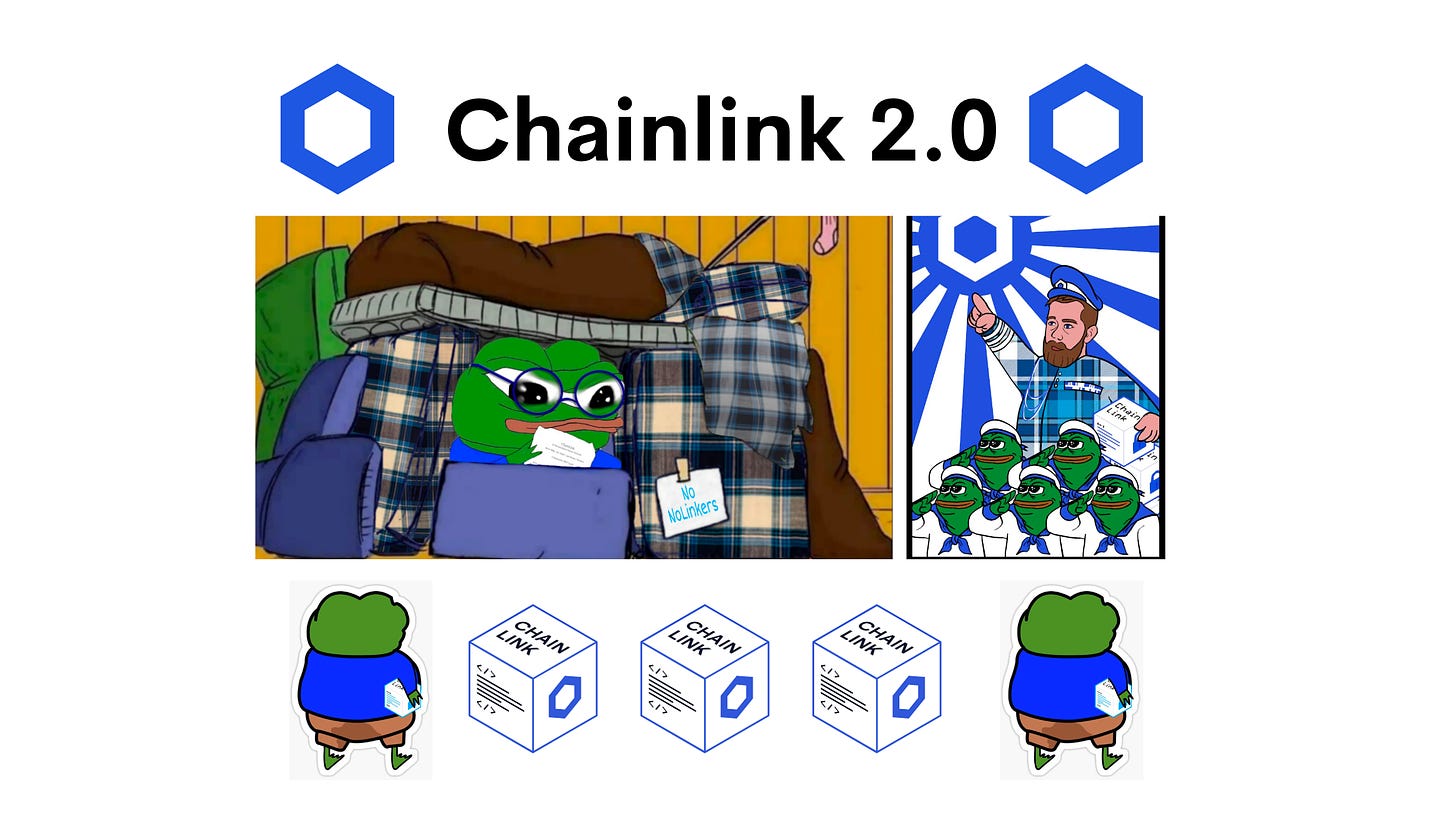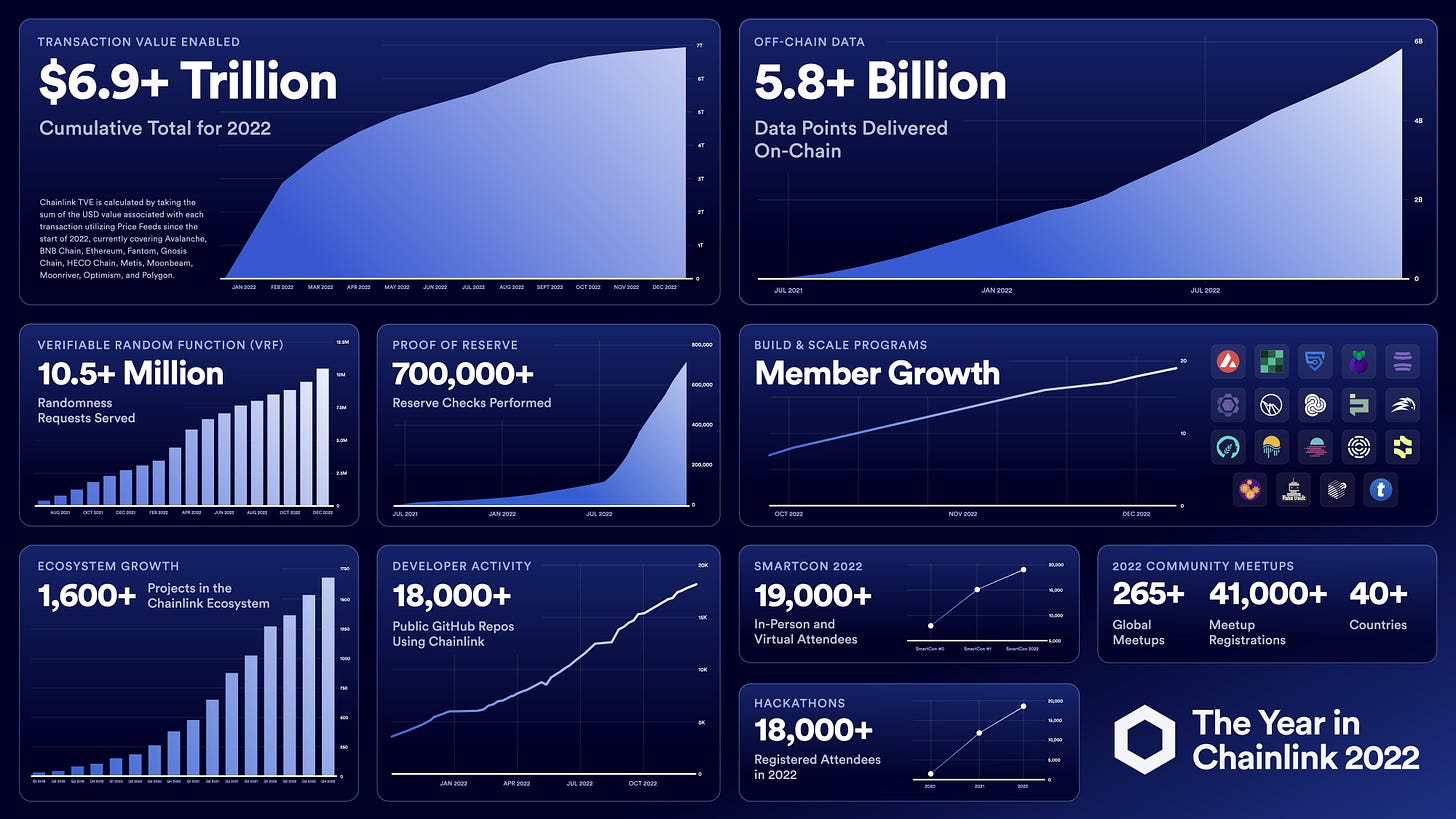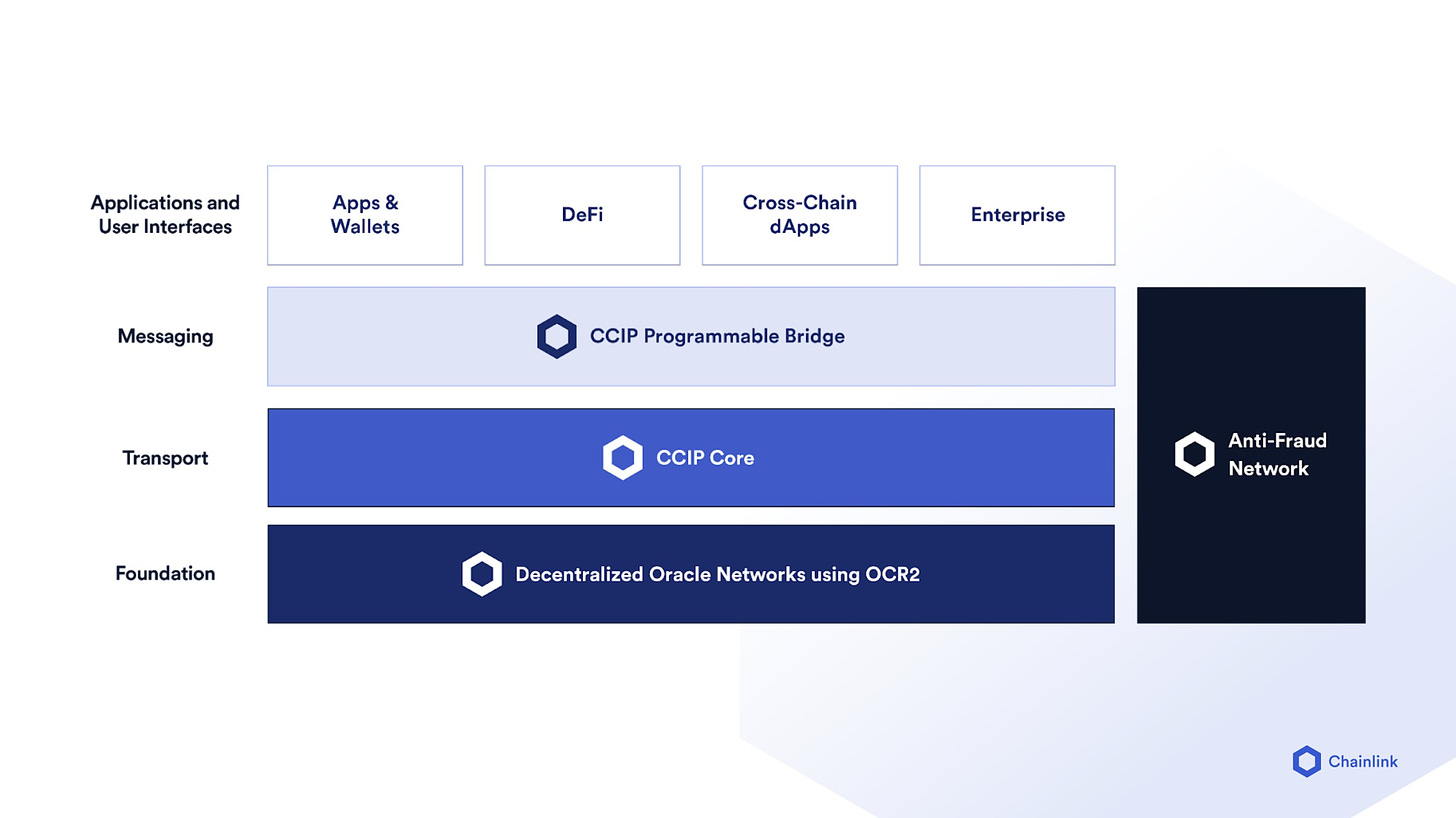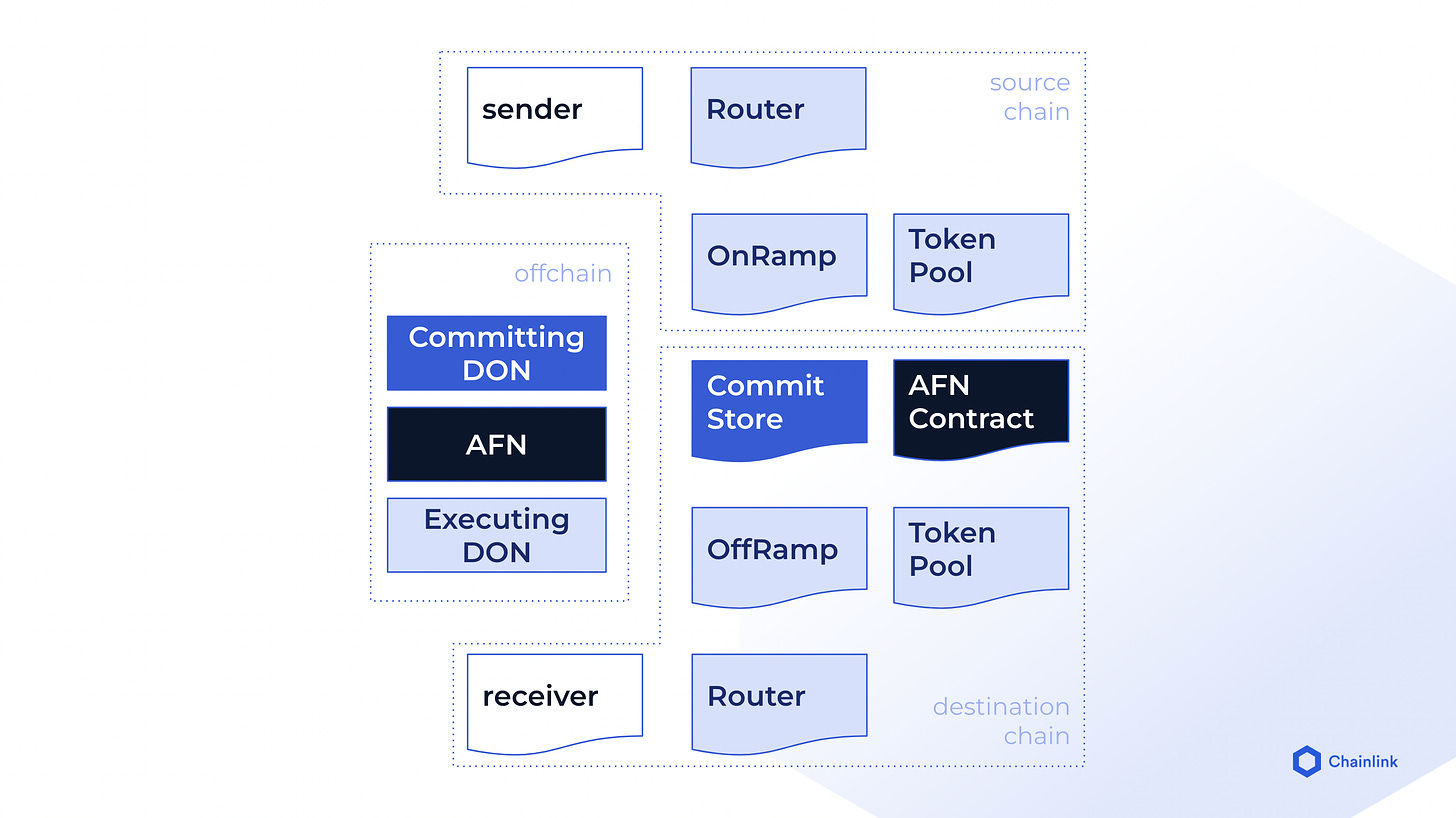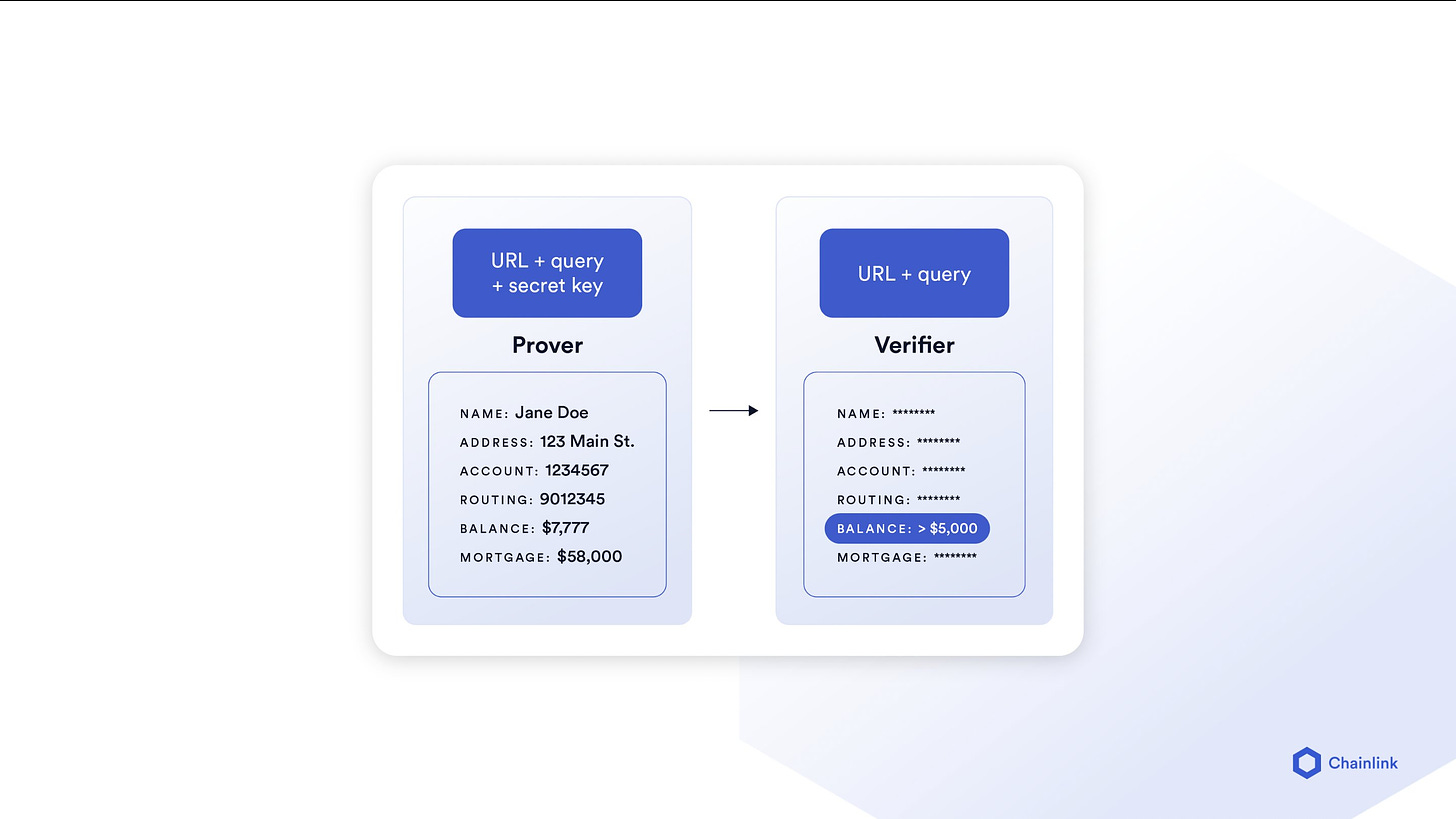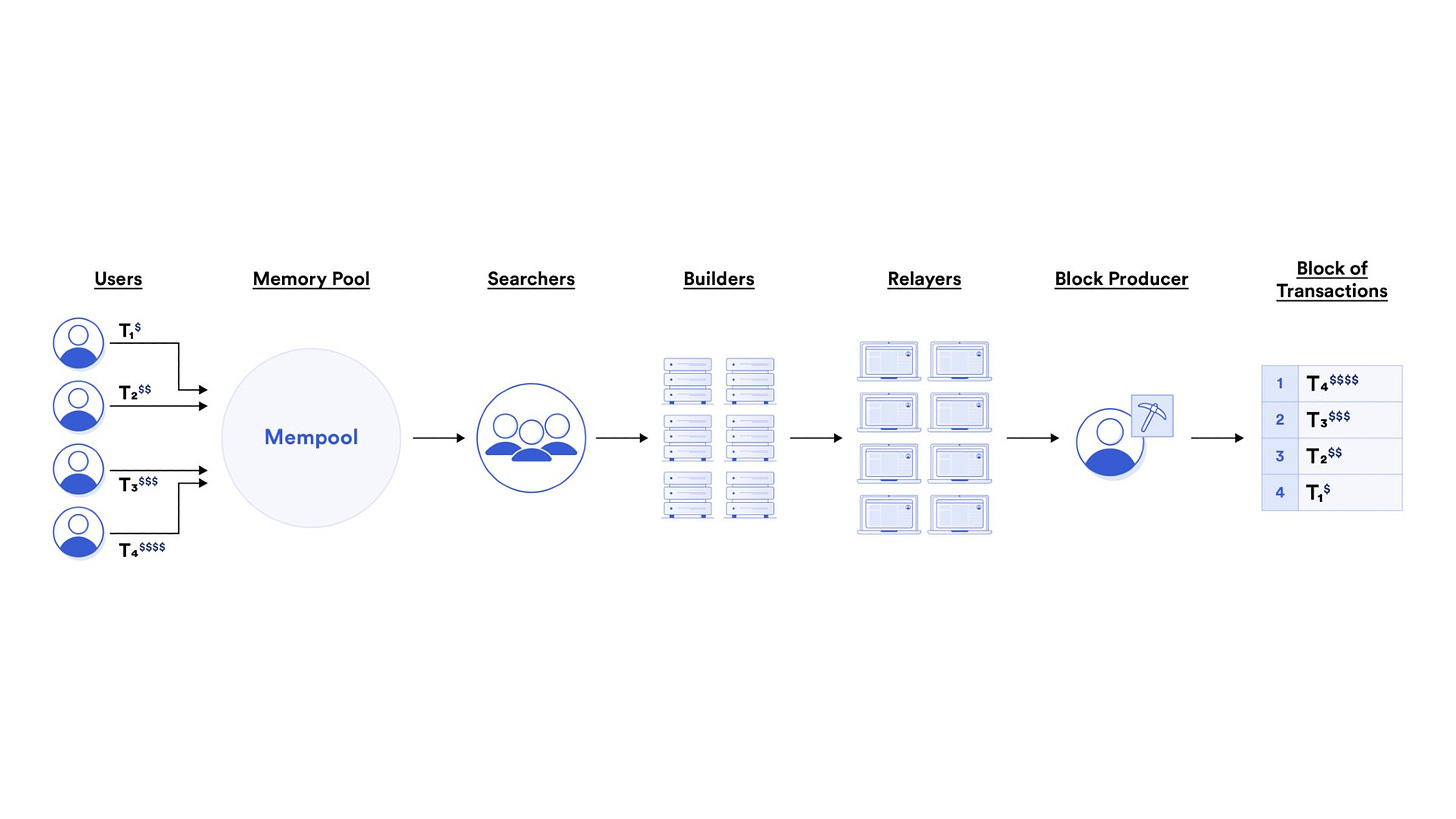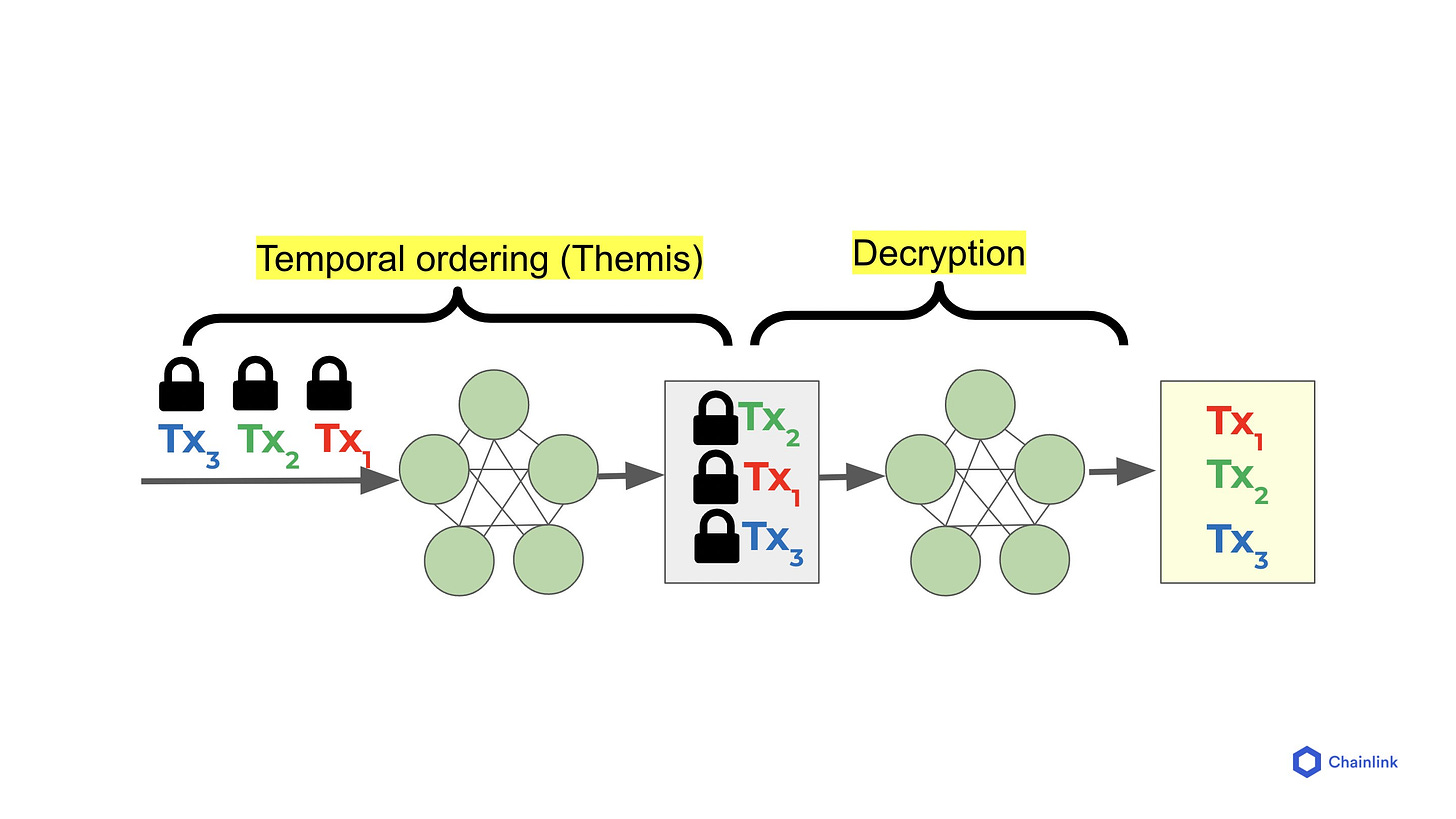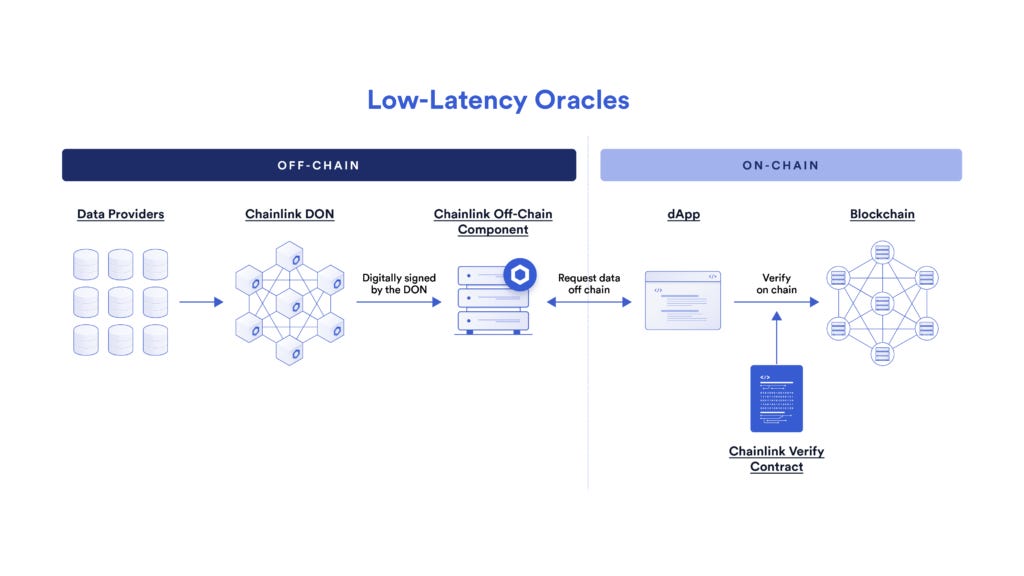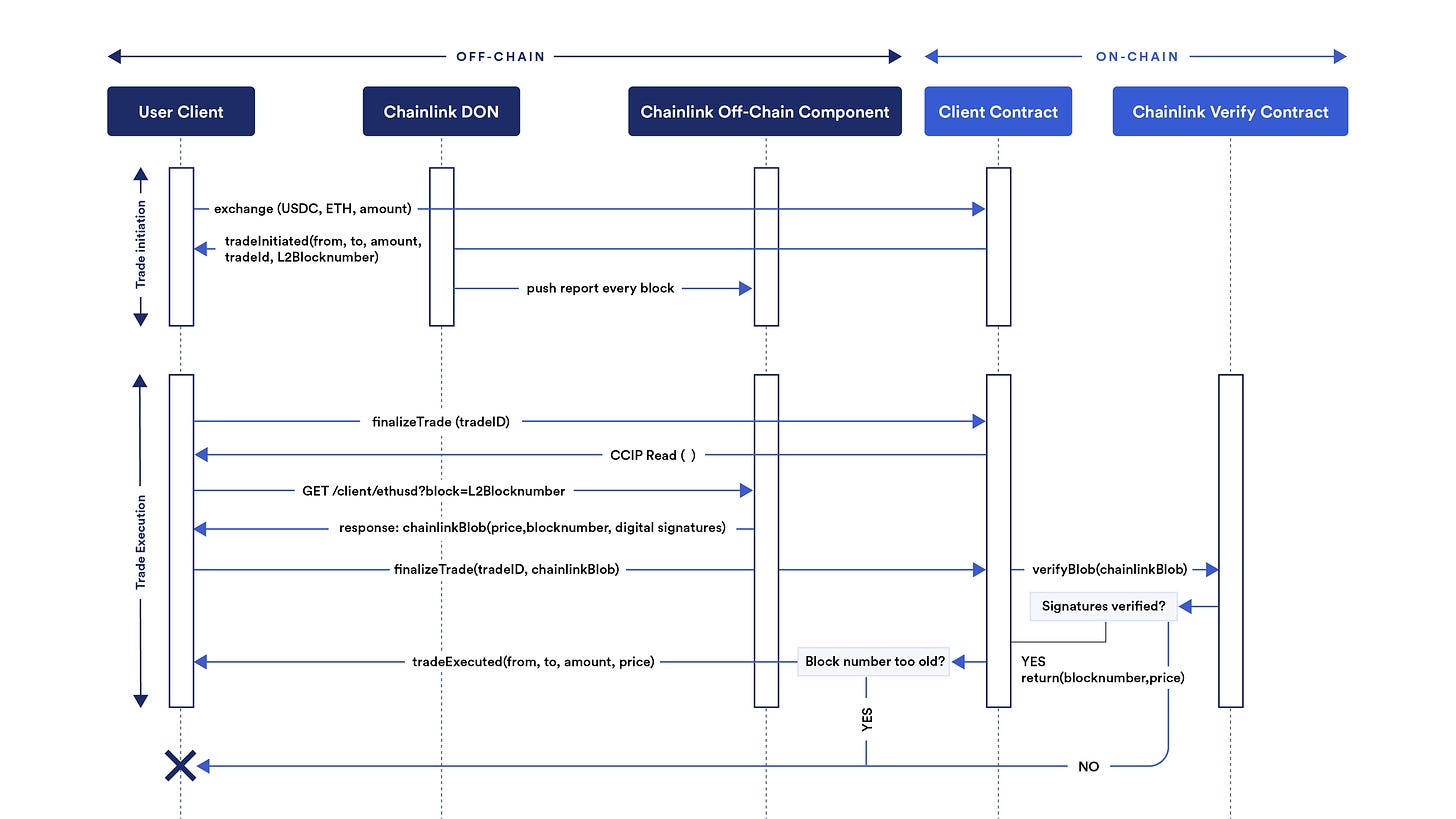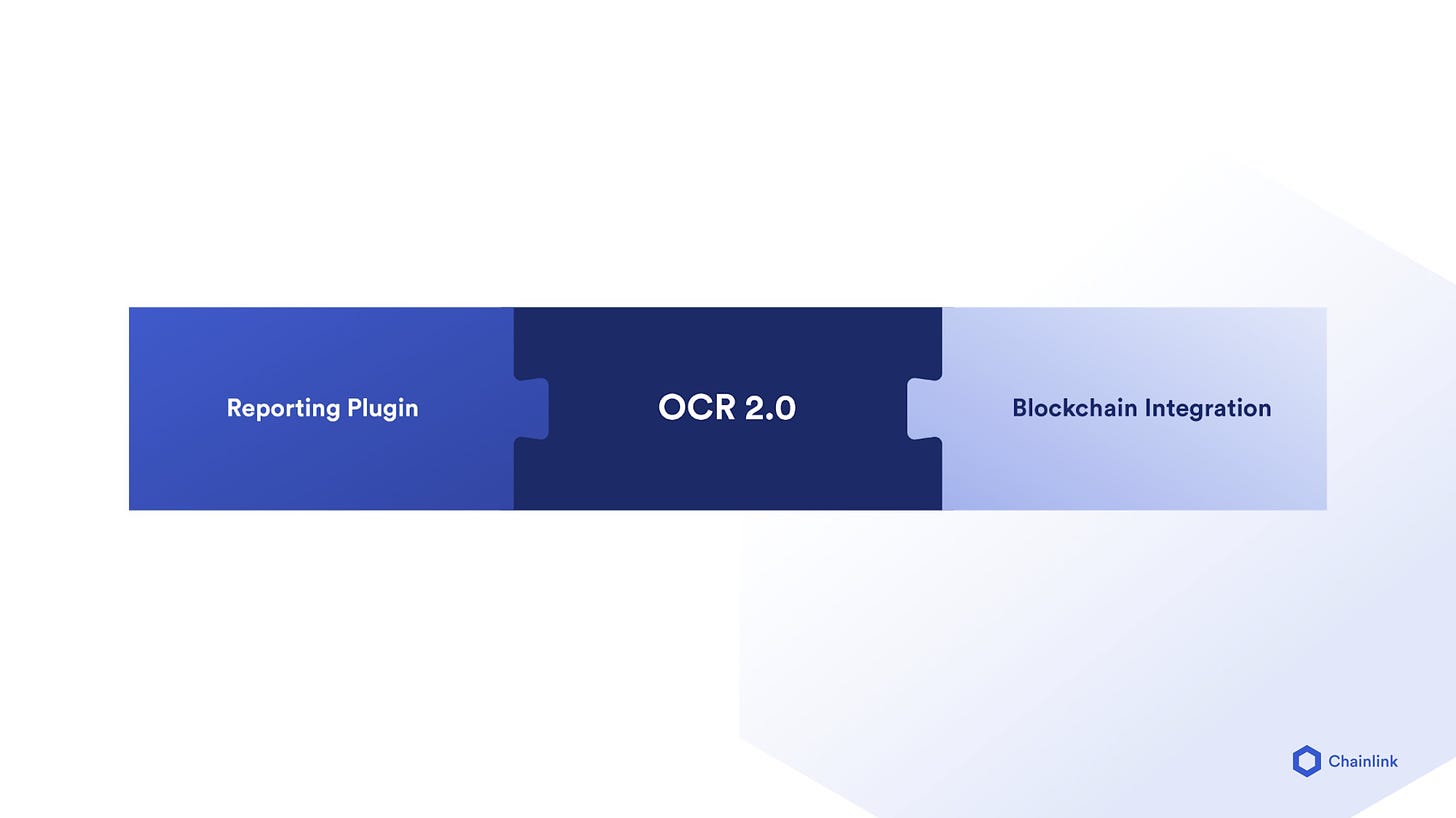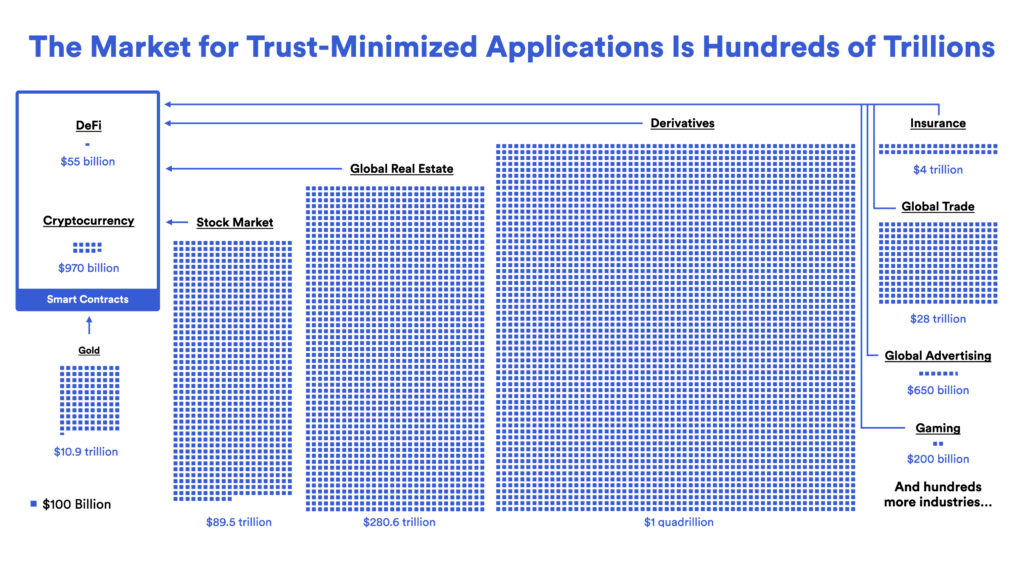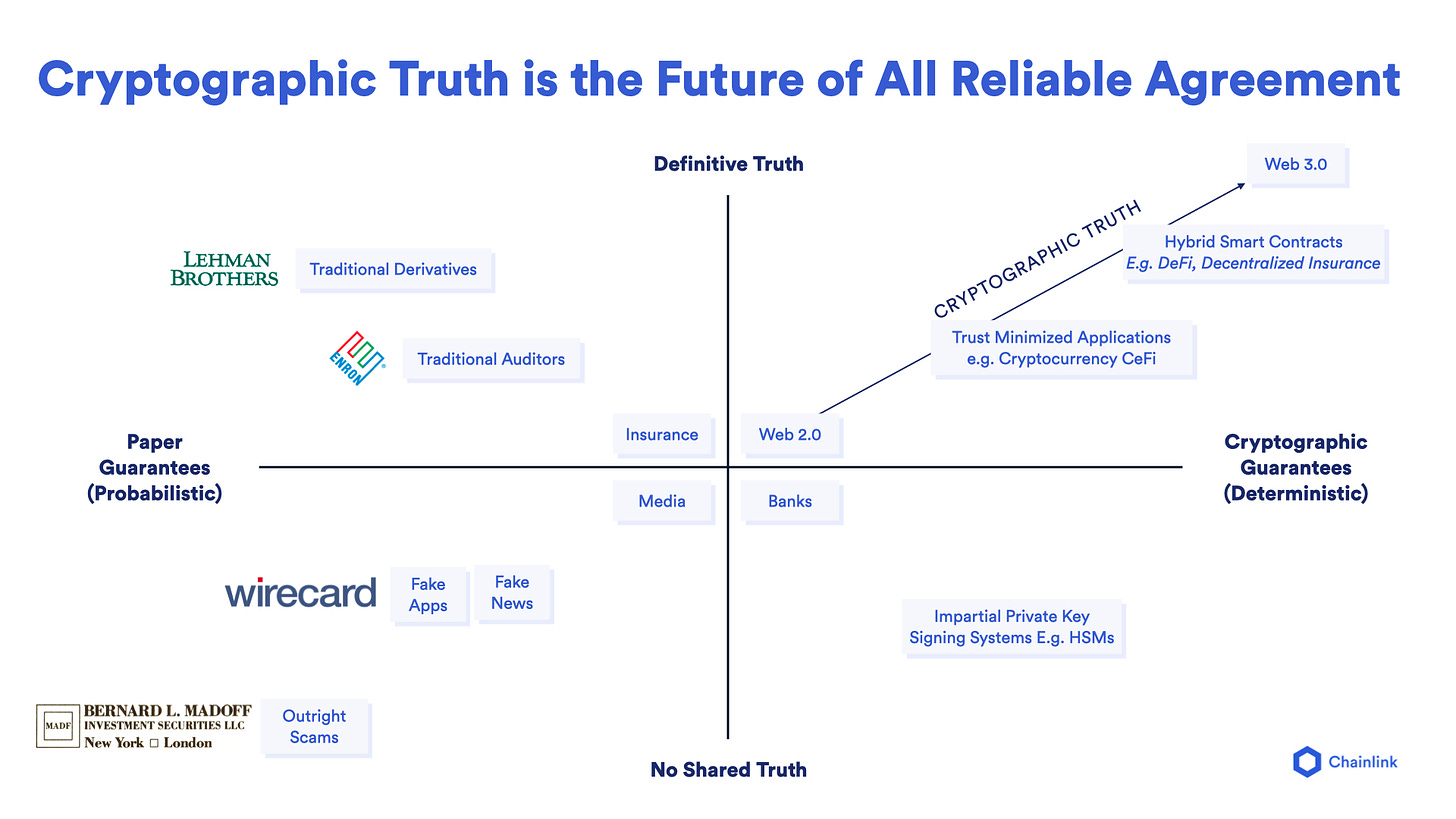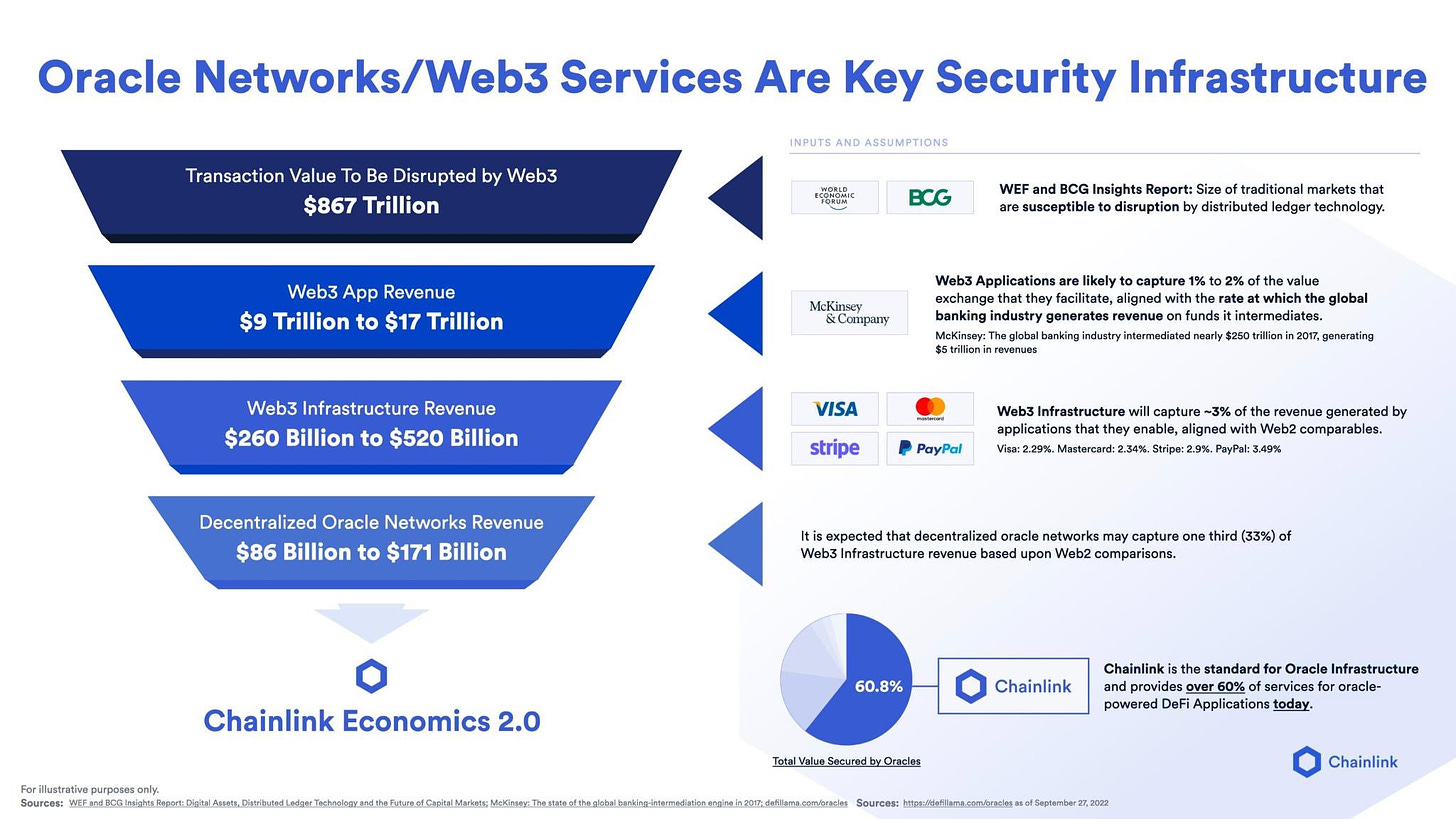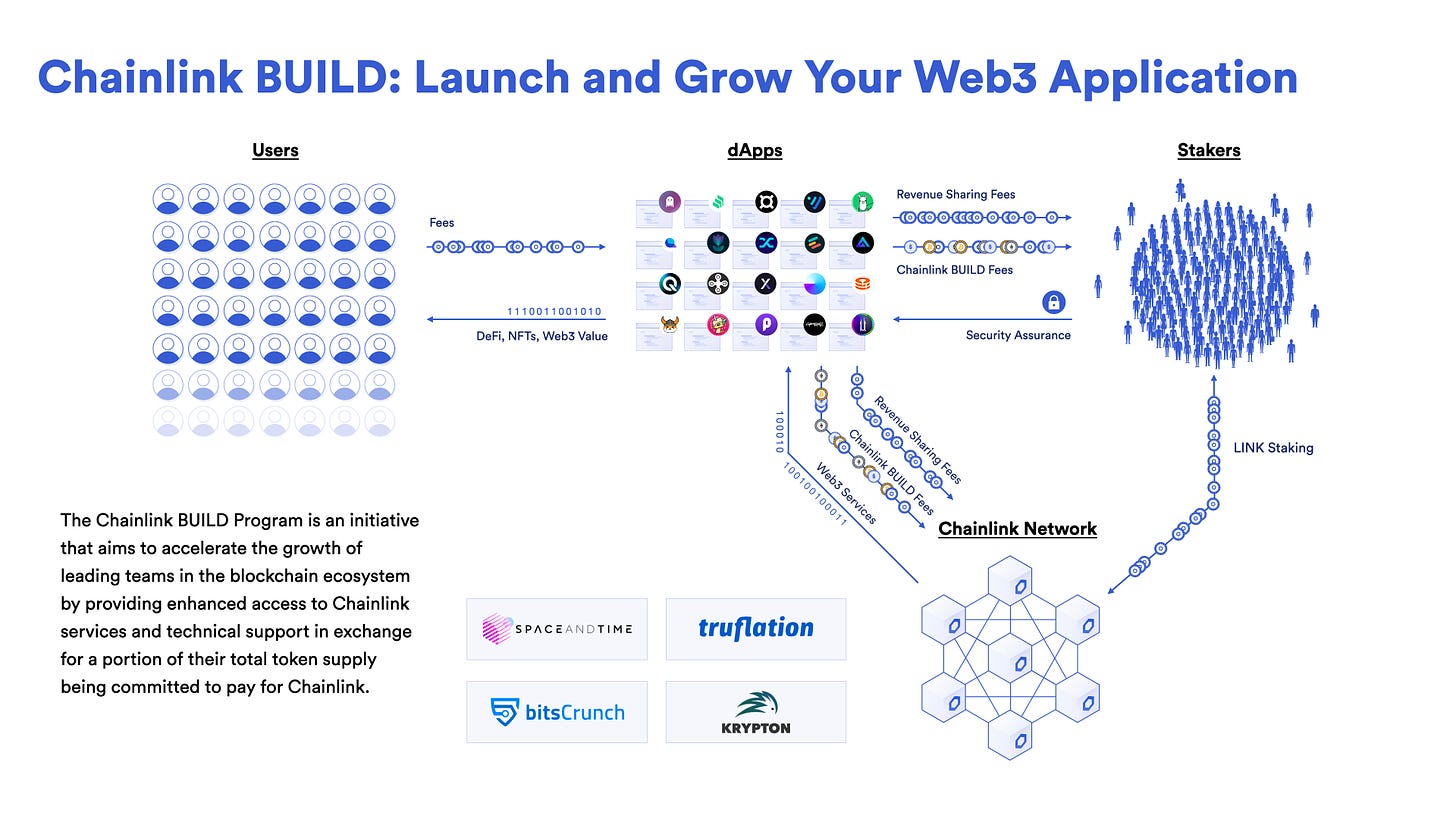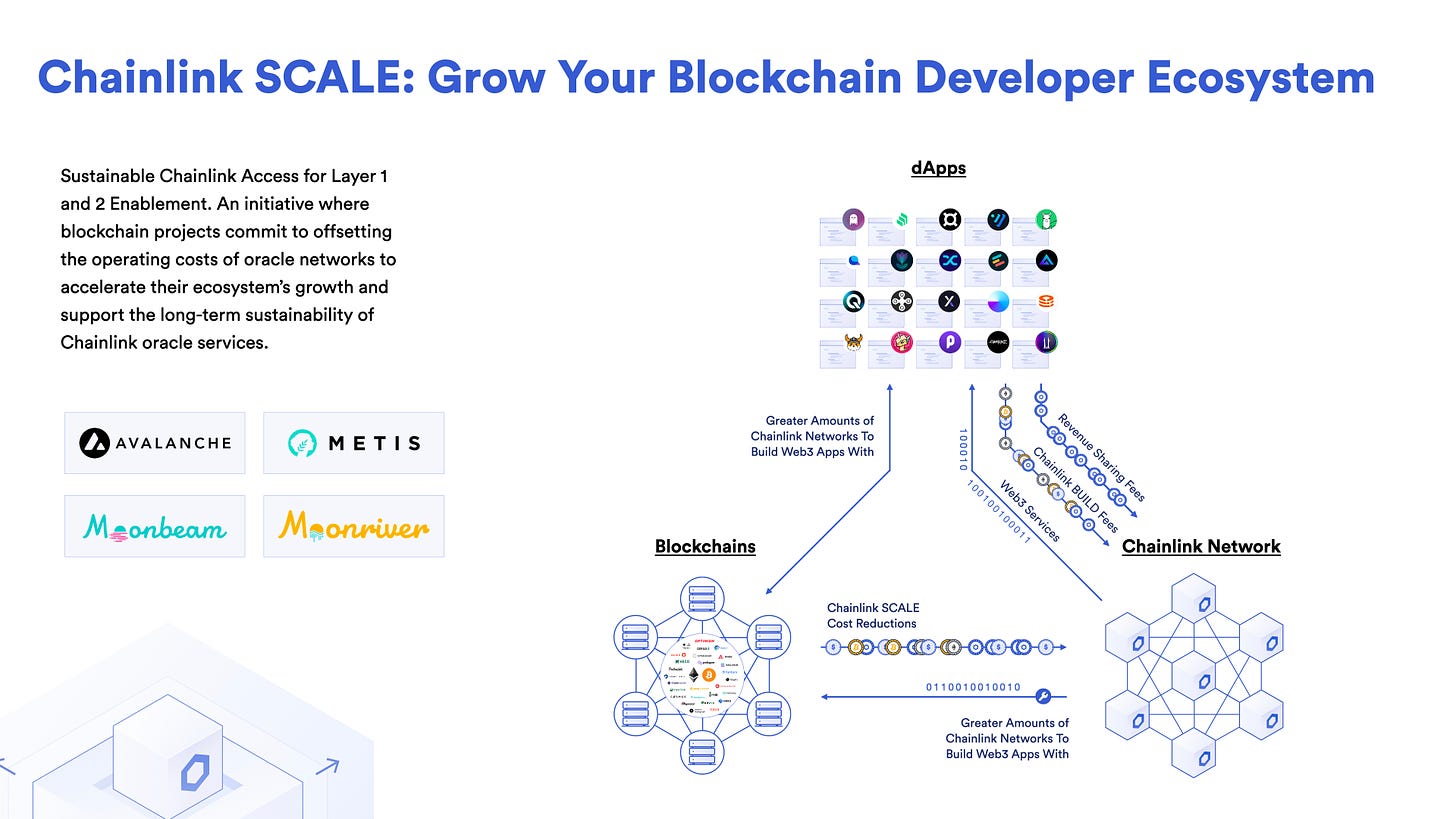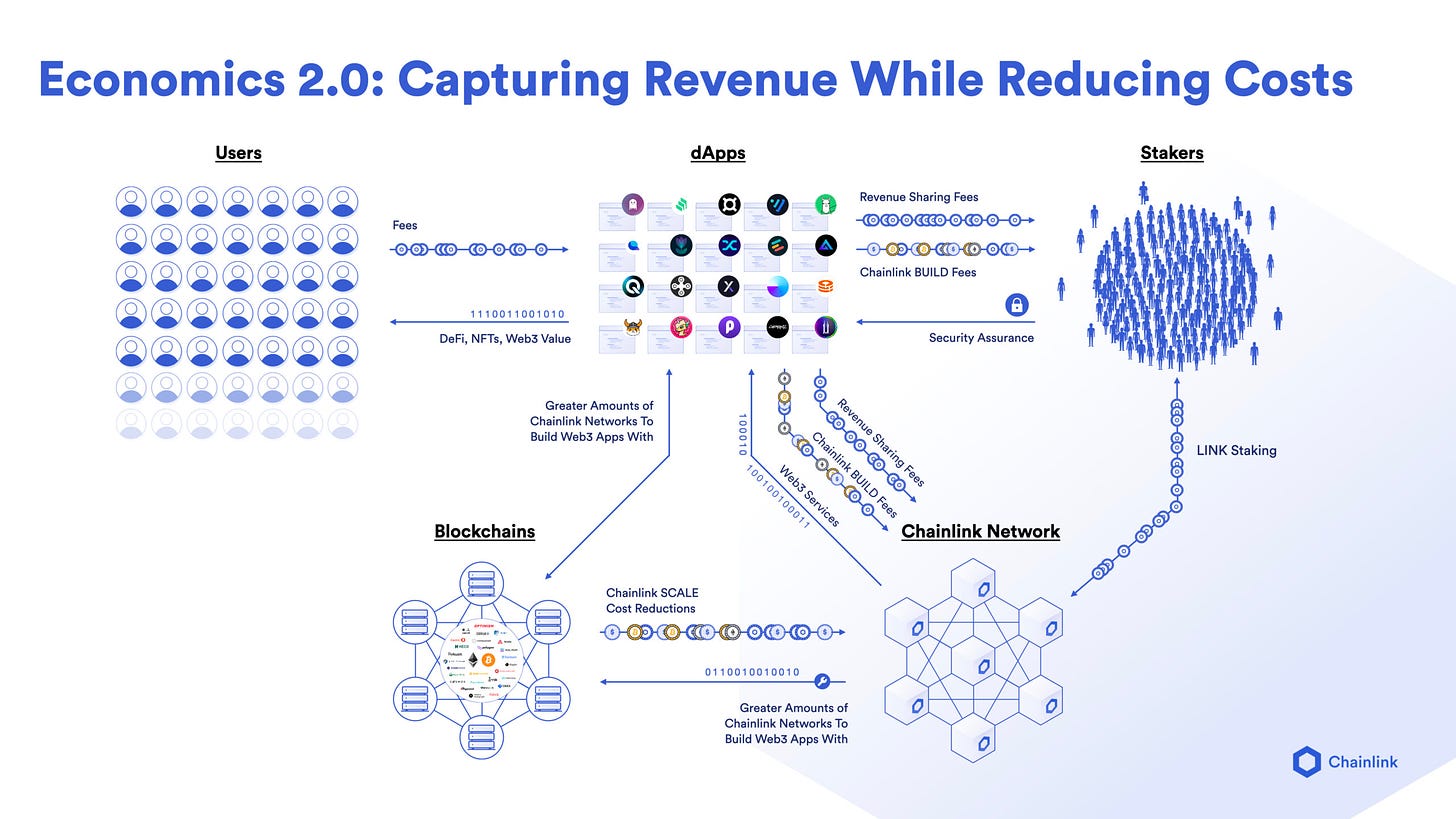Almost 90% of dApps in crypto require access to off-chain data. Most smart contract functions are not meaningful without data feeds as inputs.
Data oracle networks play a critical role in the foundational structure of the whole crypto ecosystem. It will increasingly become even more important as we bridge traditional processes from Web2 into Web3.
Chainlink is the market leader and industry standard for Oracle Infrastructure network with over 60% market share today, and certain verticals 70-90%.
In 2022, Chainlink enabled more than $6.9 trillion in transaction value and delivered $5.8+ billion on-chain data points with 1,600+ projects in the Chainlink ecosystem.
DeFi, in its present form, has validated the need for Chainlink oracles. The next step will be scaling across other verticals such as Real World Assets (RWAs), gaming, social, and other industries.
Chainlink is not one to be faded, and here are a few key developments to look out for in 2023 and beyond.
Chainlink Product Overview
Chainlink CCIP
Chainlink VRF v2
Chainlink DECO
Chainlink FSS
Chainlink low-latency oracles
Chainlink NFT floor price
Chainlink OCR 2.0
Chainlink Staking v0.1
Chainlink CCIP
Cross-chain interoperability remains a big problem today, preventing mass adoption. dApps have difficulty communicating with each other from different isolated chains.
Vitalik shared his vision that the future of blockchain will be one of multi-chain and Haseeb Qureshi from Dragonfly Capital mentioned that the true endgame is generalized cross-chain messaging.
While Cosmos, Layer Zero, Synapse, Multichain and etc., are working on their respective unique solutions, Chainlink is also developing its own CCIP, an open-source standard for cross-chain communication via a single standardized interface.
Chainlink is live on 15 chains, and CCIP is the glue that connects them all.
In its most basic definition, CCIP enables a sender to send a message from a source chain to a receiver on a destination chain.
The message being anywhere from a simple token transfer between chains or more advanced complexities like cross-chain collateral, lending, governance voting and etc.
CCIP seeks to do what TCP/IP did for the internet, a communication framework allowing messages to be sent across the internet.
TCP defines how applications create communication channels, and how messages are broken into packets before being transmitted over the internet.
IP defines how messages are transmitted and routed through the network to the destination.
In the same fashion for Chainlink, the CCIP programmable bridge is the messaging layer and CCIP core, the transport layer through Chainlink’s Decentralized Oracle Networks (DONs).
On top of that, you have an independent anti-fraud network serving as an additional layer of defense to monitor malicious activities.
The extension of testing and security review timelines for CCIP was pushed back to Dec 2022. It was delayed because the commercial stakes were high, and bridges are risky.
More than $100b+ in total value bridged for 2022, and about $2b was hacked/exploited by sophisticated parties, including state-level actors.
In Sep 2022, SWIFT, the interbank communication channel, officially announced it is exploring Chainlink’s CCIP in an initial PoC to enable SWIFT messages for on-chain message transfers.
Interest from institutional investors moving into crypto has been “undeniable,”
- Jonathan Ehrenfeld Solé, SWIFT’s Strategy Director.
Chainlink is building for the long term to secure trillions in value, and security, stability, and reliability are the top priority.
There is a huge market for cross-chain messaging, to whoever gets there first.
Chainlink Verifiable Randomness Function (VRF) v2
Chainlink Verifiable Randomness Function (VRF) v2 is the industry standard random number generator solution for smart contracts.
Chainlink VRF is typically used in applications like games, social, and NFTs to generate a fair outcome for users.
For example, fair NFT minting, random NFT, Loot Box Drops, lucky draws, community giveaways, PvP games, and queueing systems, to name a few.
Randomness is important for many applications’ use cases, so it has to be unpredictable, unbiased, verifiable, lively, and secure.
With the rise of social/gaming applications, VRF will become more widely adopted.
In VRF v2, Chainlink has a new subscription model where you pre-fund into an account so that applications don’t have to pay every instance whenever a randomness request is called. This upgrade reduces the total gas cost from v1.
But there are also many alternative competitions for generating secure randomness, proposing free gas cost, with the most recent one being Paradigm’s SNARKs and VDFs
Chainlink Privacy Oracles DECO
For privacy-preserving oracles, even though Chainlink oracles have brought 5.8+ billion data points on-chain, most data are public.
The large chunk of valuable data is sensitive, confidential information stored in proprietary databases requiring auth sign-in keys and is typically not accessible to traditional oracles.
DECO helps to unlock the data, capabilities, and services that are locked in Web2 by bridging them securely and in a privacy-preserving way to Web3. It can provide provenance, privacy, and compatibility with existing standard TLS-secured API.
This is particularly useful for verticals such as under-collateralized lending in DeFi, where lenders want information on the creditworthiness of borrowers, but most of such information regarding identity, and assets reside off-chain in private databases not accessible to data oracles.
Privacy on smart contracts is one of the missing ingredients in crypto today, and it could open up new innovative use cases when private data can be accessed and proven on-chain.
Chainlink DECO is in its alpha phase.
Chainlink Fair Sequencing Service (FSS)
For FSS, the problems with blockchain are that data is public in the mempool, and the transaction ordering into a block is centralized, leading to the plaguing MEV problem. Validators often collude with other actors like searchers, builders, and relayers to extract MEV.
Chainlink’s FSS aims to build tools for fairer transaction ordering by having DONs that decide the ordering of transactions instead of validators.
While it may seem counter-intuitive that oracles should be involved in the transaction ordering of a block, but what DONs do best at their job is observing something off-chain and reporting it on-chain.
It collects user transactions off-chain, generates decentralized consensus for transaction ordering, and submits the ordered transactions on-chain in a decentralized manner.
In FSS, transactions are ordered through 1) temporal ordering (FIFO) and 2) encryption/decryption. Payload transactions are encrypted first to prevent front-running and temporally ordered FIFO before decryption.
FSS can be used at the pre-processing stage on the smart contract application layer, PBS builders for block-building, or in L2 rollups for sequencers.
FSS is already a working prototype. Arbitrum has signaled its intent to use Chainlink’s FSS, but the partnership has not materialized yet.
Low-Latency Oracles for DeFi Derivatives
In oracle networks, latency refers to the time period it takes for an oracle report to be confirmed on-chain. It could be thought of as the staleness/freshness of a data point measuring how much time has passed since the last update.
DeFi derivatives applications, such as on-chain perpetual futures, demand price feeds to come in high frequencies with low latency or the time gap will introduce MEV front-running opportunities.
Chainlink has a new low-latency oracle solution launched in Nov 2022 to serve the derivatives market. It leverages high-speed data providers with Chainlink’s DON to deliver high-frequency pricing data off-chain, yet provide on-chain verification.
In this new model, an extra off-chain component is inserted between the DON and the client contract.
Instead of pushing an aggregated data feed on-chain for every client contract call, oracle reports are generated per block using a pull-based approach and stored in the off-chain component.
Whenever users make a transaction, the data can be retrieved off-chain with the latest data and verified on-chain with a signature. The client contract then performs a staleness check and settles the trade. If it is outdated, the transaction will revert.
Chainlink’s new low-latency oracles will reduce gas costs significantly and enable more powerful DeFi derivatives to be built upon.
Chainlink NFT Floor Price Feeds
In collaboration with Coinbase Cloud, Chainlink has developed an NFT floor price feed in Sep 2022.
The first 10 NFT collections supported by the feeds are Azuki, BAYC, CloneX, Cool Cats, CrypToadz, CryptoPunks, Doodles, Mutant Apes, Vee Friends, and World of Women.
NFT has previously been isolated from DeFi applications, but we are observing the convergence between NFT and DeFi trending now with NFT floor prices.
Applications such as NFTX, FloorDAO, BendDAO, Nftperp, are creating NFT-Fi features such as lending, borrowing leverage, trading, NFT index and etc.
However, how NFT floor prices are calculated varies across protocols and could be subject to manipulation, such as wash trading or floor sweeping by whales.
There is a lack of framework and standardization, which is crucial for the NFT-Fi vertical to gain adoption and scale.
Chainlink NFT floor price uses Coinbase Cloud to scan price data across prominent NFT marketplaces to filter outliers and wash trading, before averaging to arrive at a single floor price delivered on-chain through Chainlink’s DON.
NFTs continue to unlock new frontiers in Web3, with Reddit, Starbucks, Twitter, and demand for floor price data will grow in the next few years.
Chainlink Off-Chain Reporting 2.0 (OCR 2.0)
Chainlink’s OCR 1.0 is the core of how off-chain data feed is transmitted on-chain through Chainlink nodes (DONs).
DONs fetch, sign, broadcast, validate data and aggregate all of them into a single report off-chain before pushing it on-chain as a single value and transaction to save gas costs.
A simple analogy would be to imagine sending 10 items in 10 different delivery trips, packaging cost vs. sending 1 delivery of 10 items in a single package.
Now that Chainlink is multi-chain with various products under its hood, it needs a standardized framework (OCR 2.0) for the DONs to communicate with each other more efficiently.
OCR 2.0 creates a common template plugin that is more scalable, flexible, and modular. Other Chainlink products, such as CCIP, VRF, automation and etc., can be integrated together with OCR 2.0 and customized individually for different needs and functions.
In short, OCR 1.0 is designed to power data feeds. OCR 2.0 is a reporting plugin that not only sends data feed but also allows for the expression of logic for different oracle services using the same framework.
OCR 2.0 reduced the gas cost of EVM data feeds by about 25%, is more responsive, and has lower latency and higher throughput.
Market Opportunity
Taking a step back, Chainlink’s value proposition is to refactor existing data and value into a cryptographic reliable truth in web3. There are hundreds of trillions in transaction value to be disrupted right now.
Crypto is just at a trillion right now.
The pivotal moment for Chainlink would be when the cost to generate deterministic definitive truth in web3 is cheaper than that of probabilistic trust from centralized entities in web2.
Looking at capital markets alone, that industry is worth $867 trillion based on estimates from BCG.
If we were to take a conservative market share of 1-2%, that would translate to Web3 app revenue of around $9 trillion to $17 trillion. There are big banks today that are already experimenting with blockchain to transfer tokens and value around.
The next question is what portion of this revenue would accrue to infrastructure. Based on a 3% take rate reference on existing payment networks like Visa, Mastercard, Stripe, and PayPal, the estimated Web3 Infrastructure revenue will be around $260b to $520b.
And the current estimate that will flow to the decentralized oracle networks is around 33% or around $780m to $1.5b. The estimate is arbitrary and may change accordingly.
Chainlink Economics 2.0
The transaction value enabled for Chainlink is consistently growing in a steady uptrend, and a new structure is needed to align Chainlink’s value capture and crypto-economic security.
The 3 primary aspects are:
Chainlink BUILD (Increasing Revenue)
Chainlink SCALE (Reducing Cost)
Chainlink Staking
Chainlink BUILD is the first initiative of Chainlink economics 2.0. It works with pre-revenue dApps to commit a portion of their token supply (typically between 3-5%) in exchange for oracle services and technical support.
dApps can leverage, grow, and scale their product adoption with Chainlink oracles, and Chainlink can have an additional diversified source of revenue flow from projects.
Once they reach a certain stage of maturity and self-sustainability, they can transition from tokens to revenue sharing, where the Chainlink network earns a portion of the dApp’s revenue.
Chainlink SCALE seeks to reduce the on-chain operating costs, by as much as 50% to 99%, for Chainlink nodes.
Different L1/L2 chains, or in the future app chains, would cover the operational costs for Chainlink nodes. In return, developers building on the respective chains would have greater access to Chainlink’s oracle services, enabling more dApps to be built, thus attracting more users and TVL for the chain and revenue for Chainlink.
Avalanche, Metis, Moonbeam, and Moonriver have confirmed their participation in Chainlink SCALE to cover certain oracle network operating costs.
Chainlink Staking v0.1
Chainlink staking v0.1 is a beta release launched only in Dec 2022. It’s very much in the early development phase.
The first staking pool will be capped at 25m LINK tokens representing about 2.5% of the total LINK supply. It plans to scale up to 75m LINK over time.
The initial Community Pool allotment of Chainlink Staking v0.1 is already 100% filled, and you can’t stake LINK until the next phase.
Stakers earn rewards for helping to secure the data feed by participating in a decentralized alerting system that flags if the data feed has not met certain performance requirements with regard to uptime.
There are two types of stakers, node operator stakers (2.5m allocation) and community stakers (22.5m allocation). The base reward is about 5% LINK per year, but the effective annualized reward rate for node operators is around 7% and stakers 4.75% due to a 5% delegation fee paid from community stakers to node stakers.
The accumulated rewards will be locked up in a smart contract until a future release of staking.
Research and development are already underway for staking v0.2 (ETA 9-12 months~)
Conclusion
Chainlink Economics 2.0 is a new chapter in Chainlink’s value capture and crypto-economic security.
The long-term bullish thesis for Chainlink is a future where hundreds and trillions of transaction value and data from every industry in the global economy flow through Chainlink’s decentralized oracle networks to power the entire crypto economy.
Chainlink stakers earn a portion of fees from data feed/service called from hundreds and thousands of applications, along with a diversified revenue stream and tokens from early-stage projects partnered up with Chainlink.
Given its first-mover advantage, quality, reliability, and institutional partnerships, Chainlink has a shot at becoming the data infrastructure rails of the crypto economy, similar to how SWIFT or Visa/Mastercard is the payment rails of the global economy.




